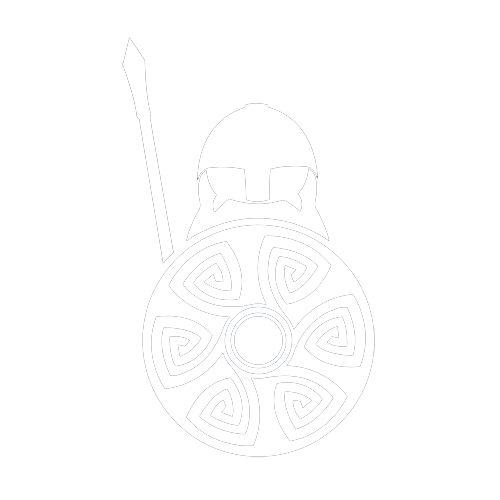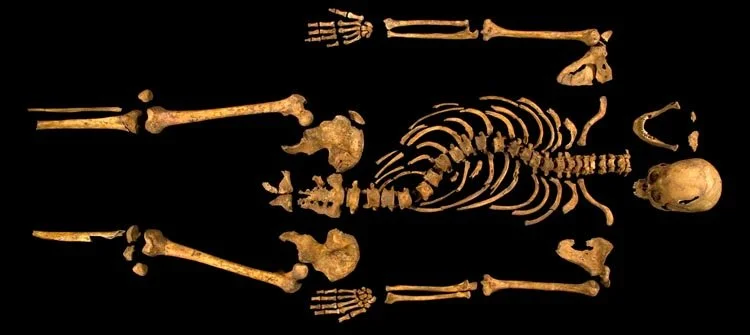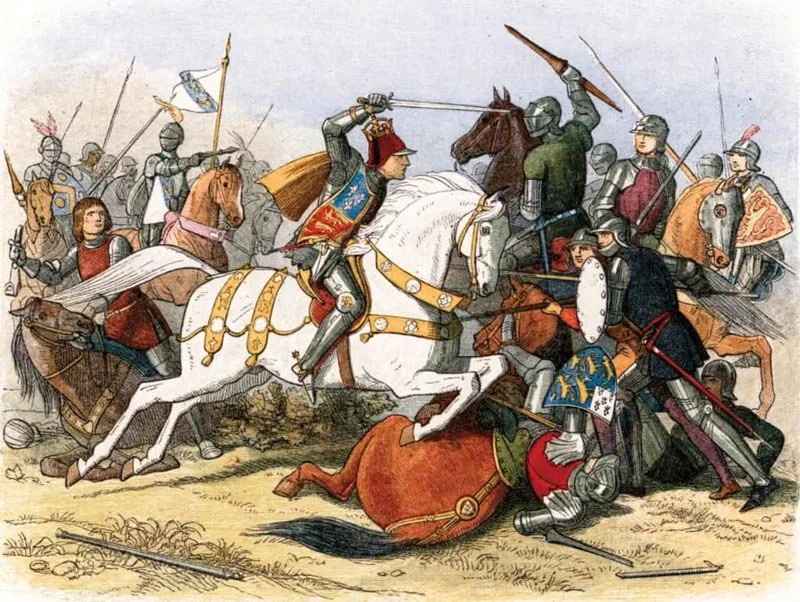King Richard III the Last Medieval King
King Richard III was the fourth son of Richard, Duke of York and Cecily Neville. His reign is blighted with unproven murders, which began when he seized the throne from his nephew, Edward V. The mysterious disappearance of the young princes in the Tower, and the nature of his physical appearance, Richard III’s reputation has suffered harshly through time. But with no evidence to support these crimes, he should be remembered as a powerful duke, king and warrior, which ultimately led to his death on the battlefield, fighting in the last battle of the Wars of the Roses.
| Born | 2 October 1452, Fotheringhay Castle, Northamptonshire |
| Parents | Richard Duke of York and Cecily Neville |
| Married | Anne Neville |
| Children | 3 |
| Died | 22 August 1485, Battle of Bosworth, Leicestershire (32) |
| Reign | 1483 - 1485 (2) |
| Crowned | 6 July 1483, Westminster Abbey (30) |
| Predecessor | Edward V (nephew) |
| Successor | Henry VII Tudor (distant cousin) |
| House | York |
Life Events of King Richard III
1452
On 2 October, Richard III is born to Richard Plantagenet, Duke of York and Cecily Neville, their fourth son, at Fotheringhay Castle, Northamptonshire.
1461
On 1 November, Richard is granted the Duchy of Gloucester by his brother, Edward IV.
1462
On 12 August, Richard is granted Lordships of Richmond, Yorkshire and Pembroke, Wales as well as large estates in northern England.
1471
Richard becomes constable of both Gloucester and Corfe Castle, and Lord High Admiral of England.
1471
In May, a month after the defeat of Richard Neville, Earl of Warwick at the Battle of Barnet, Richard gained Warwick’s lands and titles too.
1480
On 12 May, Richard Duke of Gloucester is appointed Lieutenant-General of the North, as fears of a Scottish invasion grows. For the next two years, Richard launches counter raids and skirmishes against Scotland and her allies.
1483
On 19 May, Richard escorts his nephew, Edward V, to the royal apartments at the Tower of London.
1483
On 25 June, an assembly of Lords and Commons declare Richard Duke of Gloucester, king of England, Edward V is deemed illegitimate. On 25 June, an assembly of Lords and Commons declare Richard Duke of Gloucester, king of England, Edward V is deemed illegitimate. Richard becomes king the next day, on 26 June.
1483
The young princes, Edward V and Richard Duke of York are moved into the inner apartments of the Tower of London.
1483
In September, the young princes are seen in the grounds of the castle for the last time.
1483
In October, King Richard III defeats the Duke of Buckingham during a rebellion, designed to put Henry Tudor on the throne. Buckingham is tried and executed in November.
1484
In April, King Richard III’s only son and heir, Edward, dies aged 9.
1485
In March, Richard III’s wife, Queen Anne, dies. Propagandists suggest Richard poisoned his wife, so he could marry his niece, Elizabeth, to prevent her marriage to Henry Tudor.
1485
In August, Henry Tudor lands at Milford Haven with an army of French mercenaries, and gathers reinforcements.
1485
On 22 August, King Richard III meets Henry Tudor at the Battle of Bosworth Field, the final battle of the Wars of the Roses.
1485
King Richard III is killed in the thick of the action, the last English monarch to die in battle, after his allies flee. Richard is stripped naked, and taken away to be buried at Greyfriars Abbey, Leicester.
1485
Henry Tudor becomes king of England, after finding the crown under a Hawthorn bush. This ends the medieval period in Britain.
Interesting Facts About King Richard III
Scoliosis
King Richard III is said to have had scoliosis, which is a curvature of the spine. It is possible that this made one of his shoulders higher than the other. The Tudors exaggerated this and blackened his name with talk of a hunchback, and how cruel and wicked Richard was. There is no evidence to suggest Richard’s back was that bad. He was formidable in battle and stood tall at five foot eight, well above the average.Murder
King Richard III is heavily associated with the murder of the young princes, his nephews, Edward V and Richard Duke of York. Richard did bring them into the royal apartments at the Tower of London, and they did disappear around September 1483. But there is no evidence to prove he murdered them. Henry Tudor had just as much to gain from their disappearance.In 1674, the skeletons of two young boys were discovered during repair work at the Tower of London, ten feet below the foot of a staircase. There is no evidence that these remains are the young princes, despite an effort in 1993, which proved they were the remains of young males, who were about the right age.
King Charles III is said to be approving of the bodies to be exhumed once more, in a hope that modern science will be able to provide more information into this medieval mystery.
Car Park
Philippa Langley spent seven years trying to work out where King Richard III was buried. The old Greyfriars monastery had long gone, and there was little to go on. She paid a visit to Leicester, and had an unexplained urge to check a private car park. As she walked over Bay 2, she felt that this was the spot.Fundraising for a two-week dig was organised, and with the support from the Richard III Society, the dig went ahead. The skeletal remains of King Richard III were there, just as she had predicted! The bones were reburied at Leicester Cathedral.
Battles Fought by King Richard III
Battle of Barnet
On 14 April 1471, Richard Duke of Gloucester joins his brother, King Edward IV, as he leads the Yorkist forces against Richard, Earl of Warwick and the Lancastrians. The Yorkists seized an advantage, while the Lancastrians were in disarray, and defeated them. Warwick is executed after the battle.Battle of Tewkesbury
On 4 May 1471, Richard Duke of Gloucester and the Yorkists, led by King Edward IV, win a decisive victory against the Lancastrians. Edward, Prince of Wales is killed in battle and Edmund Beaufort, Duke of Somerset is executed afterwards.Battle of Bosworth Field
On 22 August 1485, King Richard III leads his larger army against the forces of Henry Tudor. King Richard III’s key allies desert during the battle, to the cries of ‘Treason’ from the king. In the centre of the action, King Richard III is slain.
FAQs About the King
How did Richard III become king?
Richard III became king through a series of events known as the Wars of the Roses. After the death of his brother Edward IV, Richard served as regent for his nephew, Edward V. However, he took the throne for himself by declaring Edward IV's marriage invalid and claiming that his nephews were illegitimate.What is the significance of Richard III's reign?
Richard III's reign was relatively short, lasting from 1483 to 1485. He is known for his controversial rise to power and his defeat and death at the Battle of Bosworth Field, which marked the end of the Plantagenet dynasty and the beginning of the Tudor era.What is Richard III best known for?
Richard III is best known for his potential involvement in the murder of the ‘Princes in the Tower’. He is also well known for his portrayal in William Shakespeare's play, ‘Richard III’, as a villainous and hunchbacked king. However, modern historical research has challenged some of the negative perceptions associated with Richard III.Where is Richard III's remains discovered?
Richard III's remains were discovered under a parking lot in Leicester, England, in 2012. The excavation and subsequent DNA analysis confirmed the identity of the skeleton as Richard III.How did Richard III die?
Richard III died in the Battle of Bosworth Field on 22 August 1485. He was the last English king to die in battle. His death marked the end of the Plantagenet dynasty and the beginning of the Tudor era with the ascension of Henry VII.Was Richard III really hunchbacked?
The popular depiction of Richard III as a hunchback comes from Shakespeare's play and subsequent portrayals. However, modern historical research and analysis of Richard III's remains suggest that his physical deformity, if present, was not as extreme as portrayed.Did Richard III kill the ‘Princes in the Tower’?
The fate of the ‘Princes in the Tower’, Edward V and his brother Richard, Duke of York, remains a mystery. Richard III has been commonly accused of their murder, but conclusive evidence has not been found, and the responsibility for their disappearance is still debated among historians.Where is Richard III buried?
Following the discovery of his remains in Leicester, Richard III was reburied in 2015 at Leicester Cathedral in a tomb designed to honour his memory.
King Richard III’s skeleton (photo courtesy of the University of Leicester)
King Richard III charging at the Battle of Bosworth Field




